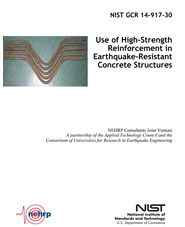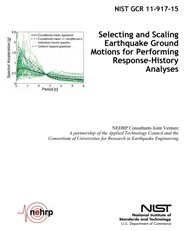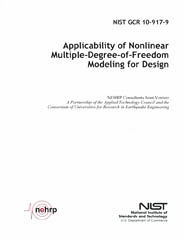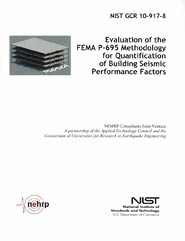 |
NIST GCR 14-917-30
Use of High-Strength Reinforcement in Earthquake-Resistant Concrete Structures
[see also: Task Order 25]
|
The purpose of this report is to document a recently completed study to evaluate whether using reinforcement with yield strength greater than 60 ksi in structural members that resist earthquake forces is appropriate in the United States. The current standard for reinforced concrete design, ACI 318-11, Building Code Requirements for Structural Concrete and Commentary (ACI, 2011), allows the use of reinforcement with a specified yield strength of 80 ksi for flexure and confinement, but limits the specified strength of reinforcement to 60 ksi in special moment frame and special structural wall (shear wall) design.
|
|
|
NIST GCR 12-917-21
Soil-Structure Interaction for Building Structure
[see also: Task Order 10]
|
This report represents an advancement in the state of Soil-structure interaction (SSI) knowledge for practicing engineers. It provides a synthesis of the body of SSI literature, distilled into a concise narrative, and harmonized under a consistent set of variables and units. Techniques are described by which SSI phenomena can be simulated in engineering practice, and specific recommendations for modeling seismic soil-structure interaction effects on building structures are provided. The resulting recommendations are illustrated and tested, in detail, on realistic example buildings.
|
|
|
NIST GCR 12-917-18
Comparison of U.S. and Chilean Building Code Requirements and Seismic Design Practice 1985–2010
[see also: Task Order 19]
|
| This work is part of a series of investigations into the performance of engineered construction during the February 27, 2010, Maule earthquake in Chile. It is intended to provide an understanding of the similarities and differences between U.S. and Chilean seismic design codes and practices so that meaningful conclusions can be drawn from the observed performance of buildings in Chile, and that seismicresistant construction can be improved in the United States.
|
|
|
NIST GCR 11-917-13
Research Plan for the Study of Seismic Behavior and Design of Deep, Slender, Wide Flange Structural Steel Beam-Column Members
[see also: Task Order 17]
|
| This report summarizes the scope of a recommended, comprehensive, long-range, experimental and analytical research plan to investigate the behavior of deep, slender wide flange structural steel beam-column members in seismic applications. The results from this research are intended to be used in the development of nationally accepted guidelines for the seismic design and assessment of deep, slender wide flange beam-column members. While emphasis is placed on special moment frame systems, application to intermediate moment frames, ordinary moment frames, and beam-column elements in braced frame systems, may also be possible.
|
 |
NIST GCR 11-917-15
Selecting and Scaling Earthquake Ground Motions for Performing Response-History Analyses
[see also: Task Order 09]
|
| This report provides guidance to design professionals on selection and scaling of ground motions for the purpose of nonlinear response-history analysis. Gaps in the current knowledge related to selecting and scaling ground motions for seismic design and performance assessment are identified, and relevant provisions in current and recent ASCE/SEI Standards are explained and clarified.
|
 |
NIST GCR 10-917-9
Applicability of Nonlinear Multiple-Degree-of-Freedom Modeling for Design
[see also: Task Order 06]
|
This report presents findings, conclusions, and recommendations resulting from a review of available research and practice regarding nonlinear MDOF effects, and focused analytical studies targeted to investigate selected issues related to MDOF modeling and response characteristics. The report is organized into two parts: (1) a main body of summary information and conclusions; and (2) supporting documentation contained in a series of appendices presenting the results of detailed analytical studies and findings from research and practice reviews.
|
 |
NIST GCR 10-917-8
Evaluation of the FEMA P-695 Methodology for Quantification of Building Seismic Performance Factors
[see also: Task Order 01] and
[see also: Task Order 04]
|
This report presents the results of expanded testing of the FEMA P-695 Methodology, summarizes findings and conclusions for the systems studied, and provides recommendations for possible improvement of the Methodology and further study related to the specification and use of seismic performance factors in seismic design codes and standards.
|
|
|
NIST GCR 10-917-7
Program Plan for the Development of Collapse Assessment and Mitigation Strategies for Existing Reinforced Concrete Buildings
[see also: Task Order 05]
|
This report and the recommendations herein focus on cast-in-place concrete construction. While existing precast concrete buildings also pose a risk of collapse in earthquakes, collapse behavior of precast concrete construction is significantly different from cast-in-place concrete buildings. Given the substantial technical differences associated with segmented construction and precast connection vulnerability, treatment of precast concrete buildings has been excluded from consideration in this program. This exclusion is not meant to imply that additional study of the collapse vulnerability of existing precast concrete buildings is unimportant, or should not be undertaken. It is recommended that future funding be focused on addressing the risk of precast concrete buildings separately and specifically.
|
For more information, please contact Jon Heintz, 650-595-1542, jheintz@atcouncil.org.
|